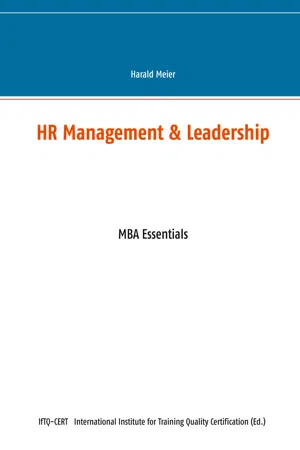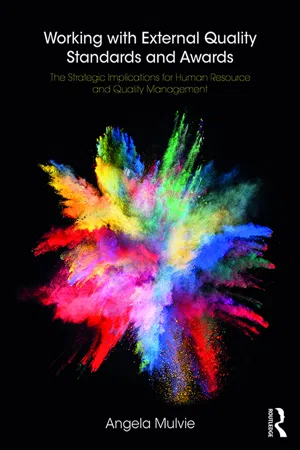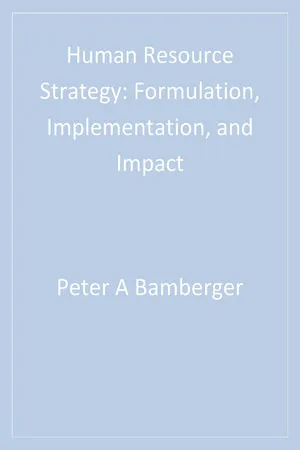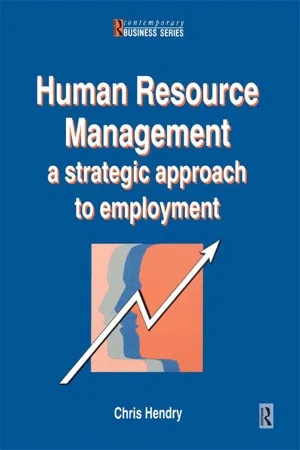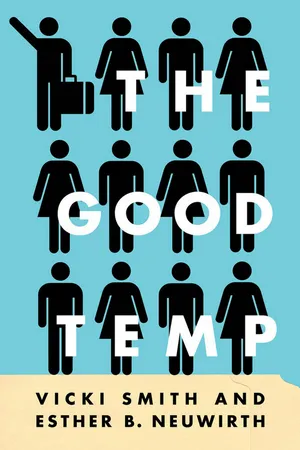Business
HR Policies
HR policies are guidelines and rules established by an organization to govern its employees' behavior, expectations, and rights. These policies cover areas such as recruitment, compensation, performance management, and employee conduct. They are designed to ensure compliance with legal requirements, promote a positive work environment, and align employee behavior with the organization's goals and values.
Written by Perlego with AI-assistance
Related key terms
7 Key excerpts on "HR Policies"
- eBook - ePub
HR Management & Leadership
MBA Essentials
- Harald Meier(Author)
- 2021(Publication Date)
- Books on Demand(Publisher)
1. HR Management Policy and Strategy- 1.1 HR Management Policy
- 1.1.1 Corporate Policy and HR Management
- 1.1.2 Governance, Compliance and Co-determination
- 1.1.3 HR and Leadership related Megatrends
- 1.1.4 Strategic HR and Human Capital Management
- 1.2 Concepts and Instruments of HR Policy
- 1.2.1 HR and Leadership Guidelines
- 1.2.2 Employee Relations, HR Research and Survey
- 1.2.3 Works Agreement
- 1.2.4 Employer Branding
- 1.2.5 Annual HR Report and Staff Meeting
- 1.2.6 Change Management
1.1 HR Management Policy
1.1.1 Corporate Policy and HR Management
Corporate Policy (policy : consciously enforcing will) is decision making and design of the long-term corporate goals and their adaptation to internal and external framework conditions or influences – as basis for following operationalized divisional, department etc. planning activities (see following example in the HR Division).Fig. 1.1: Corporate Business Plan and HR Management
- eBook - ePub
- John Stevens, Vicki Jeynes, Elvis Cotena, Mark Edelson(Authors)
- 2006(Publication Date)
- Routledge(Publisher)
CHAPTER 4
Human Resources policies and procedures
A RISK-BASED APPROACH TO POLICY DEVELOPMENT
4.1 The question must initially be asked: ‘Why have policies and procedures at all?’ The answer to this question is fundamental to understanding the concepts in this chapter. From an organisational perspective, there needs to be a top-level strategy for managing risks within the organisation. This essential responsibility for the Board or senior management team not only protects the interests of the shareholders but also ensures a safe and effective working environment. In terms of assessing corporate risks, these are associated with a wide range of business activities such as buildings, plant and machinery, finance and, of course, people. Senior management have overall responsibility for ensuring that the risks faced by the organisation are managed and minimised.4.2 The answer for Human Resources professionals is that the implementation of effective policies and procedures for Human Resources operational and regulatory requirements is key to managing Human Resources risks. As a result, not only will management fulfil this important part of their obligation to stakeholders, but they will also maximise the effectiveness of employees, thus maximising opportunities for the organisation.4.3 Mention has already been made of the psychological contract as an unwritten set of expectations within an organisation. How Human Resources professionals write policies and procedures, determine the resulting practices and communicate them to employees can significantly shape the perception of the psychological contract for existing and prospective employees.4.4 - eBook - ePub
Working with External Quality Standards and Awards
The Strategic Implications for Human Resource and Quality Management
- Angela Mulvie(Author)
- 2018(Publication Date)
- Routledge(Publisher)
Chapter 8 , some of the employee engagement awards now on offer in the marketplace also help to reflect how organizations work with this issue. The development of a specialist ISO certification, ISO 26000, also explores how a CSR agenda might support an organization’s mission and vision; its operations and processes; its stakeholders including customers, employees and communities; and how it impacts on the environment. In other words, this particular standard considers how businesses can and should operate in a socially responsible way.Research by Guest and King (2004) into how the HR function is viewed in the current climate suggests that the ambiguities of definition and application identified thirty years ago by Legge (1978) still exist in many organizations. They purport a lukewarm, sceptical reaction to the relationship between HRM/HRD and performance, although they recognize in the current climate a clearer alignment of HR people themselves with management than with the workforce. The demonstration of practical outcomes from applications of HR Policies and procedures will go some way to help with the process of acceptance of the HR field’s contribution to operational success. In the same way, dissemination of information from the measurement of the contribution of HRD, within that HRM arena, will help with determination of its value to organizational life.The resource-based view of the firm
HRM and its related strategy literature generally follows three distinct perspectives: a universalist , i.e. best practice approach which presupposes that good HR Policies and procedures will result in good performance (Pfeffer, 1998); a contingency approach which implies that different policies will be needed for different situations; and the resource-based view of the organization (Huselid, 1995) suggesting that each organization needs a unique set of policies and procedures to ensure that sustainable competitive advantage is secured by effective and efficient utilization of resources (Paauwe, 2004).Pfeffer (1998) suggests seven critical people-management policies whose use will benefit every organization. Referred to in the HR literature as the ‘bundles’ approach, their application should result in high organizational performance, yet different researchers identify different bundles as being appropriate. A meta-analysis of such an approach is difficult in that many of the studies undertaken have been cross-sectoral, some at corporate level and some at establishment level, resulting in a problem of defining causality. The contingency or ‘best fit’ approach suggests that a positive link can be established between innovative people management practices, i.e. those which have been adapted to a particular situation, and improved business performance. Yet Purcell et al. (2009) suggest this is not the case. Rather, they consider that good HR Policies on their own are not enough; they have to be adapted and a greater focus placed on the ways in which managers can and do support their implementation. In their work they have investigated their ‘black box’ problem, i.e. how the inputs in organizations (people) are transformed into outputs (performance) in a way that is often hidden from view. Commitment to staff and their subsequent increased level of motivation are two key drivers they suggest of high performing organizations, as is the role of line managers in effecting such commitment and encouraging staff to behave and perform in the required way. - eBook - ePub
- Heather Falconer, Mike Bagshaw(Authors)
- 2009(Publication Date)
- Routledge(Publisher)
Chapter SixEstablishing Effective Policies Heather Falconer IntroductionHR practitioners spend a good proportion of their working lives working on one type of policy or another. The more traditional sort, with titles such as equal opportunities, sexual harassment, and diversity, are now being added to in progressive companies by initiatives on bullying, violence, whistle-blowing, alcohol and drugs, work-life balance and more.Recently, some employers have chosen to take a more all-encompassing approach to the problem of dysfunctional conflict such as bullying and harassment by introducing ‘dignity at work’ policies. These can cover a whole range of conflict issues such as discrimination, harassment, bullying, victimisation, violence. They are designed not only to condemn negative behaviours but also to reinforce the organisation’s commitment to positive values such as dignity, respect, courtesy and fairness. They are often couched in terms of the rights and responsibilities of everyone in the workplace.The impetus for many such policies has been the perceived threat of tribunal claims and the growing likelihood of an employer being held vicariously liable for the illegal acts of its employees: organisations have long been advised that having a clear policy on issues such as harassment and discrimination will reduce the possibility of having to foot the bill.But this is not all. The past few years has seen a growth in understanding of how fair and ethical employment policies affect employee commitment, loyalty, motivation and retention. The government’s Workplace Employee Relations Survey, for example, has found that progressive employment practices result in higher productivity and morale among workers. The growing problems of stress-related illness and absenteeism have also forced some employers to confront the conflict issues causing staff to suffer sustained high levels of anxiety. - eBook - ePub
Human Resource Strategy
Formulation, Implementation, and Impact
- Peter A. Bamberger, Ilan Meshoulam(Authors)
- 2000(Publication Date)
- SAGE Publications, Inc(Publisher)
Dyer and Holder (1988) concurred with this approach and proposed a similar framework for the analysis of HR means. Their framework includes six main policy areas:- Development: policies and practices having to do with the enhancement of employee knowledge, skills and abilities
- Rewards: policies and practices relating to employee compensation and recognition
- Work system: policies and practices having to do with the design of tasks, jobs, and the workplace as a whole
- Supervision and performance management: policies and practices having to do with directing and evaluating the work of others
- Employee/labor relations: policies and practices concerning discipline, dispute resolution, and union-management relations
- Government relations: policies and practices regarding organizational compliance with government regulations
Although there is a great deal of overlap between these two frameworks for analyzing HR means at the system level, there are some obvious differences. For example, whereas Beer et al.’s (1984) framework pays little attention to policies and practices relating to union affairs, the framework proposed by Dyer and Holder (1988) neglects policies and practices influencing the flow of human resources into, within, and out of the organization. Furthermore, Dyer and Holder’s framework, though not quite at the level of specific HR functions, is far more detailed than that of Beer et al. (1984). As noted by Wright and Snell (1991), one problem with function-specific frameworks for the analysis of HR means is that researchers are unable to identify the synergies and/or conflicts among the broader, underlying realms of activity.In an effort to integrate these two approaches into a more parsimonious framework for analyzing HR means, we suggest that SHRM researchers study HR means in terms of HR subsystems. As in the case of the HR system as a whole, HR subsystems are likely to be most influenced by the policies and practices adopted and implemented by the HR function. However, as in the case of the HR system as a whole, the policies and practices adopted by other organizational functions are likely to also shape the nature of these subsystems. Furthermore, an analysis of HR means at the subsystem level focuses on broader realms of activity and is thus able to capture the synergies among unique but related policies and practices. An analysis of HR means at the subsystem level therefore offers researchers a mechanism to examine broad realms of HR-related activity without neglecting the impact of non-HR functions. - eBook - ePub
- Chris Hendry(Author)
- 2012(Publication Date)
- Routledge(Publisher)
1 Human resource management: an overview
DOI: 10.4324/9780080517872-1Introduction
Human resource management (HRM) has gained rapid and widespread acceptance as a new term for managing employment. It remains, however, an ambiguous concept. People question whether it is any different from traditional personnel management, nor is it altogether clear what it consists of in practice.This chapter sets out the background of ideas on which HRM is based. Three common interpretations are identified. HRM is then compared with personnel management, identifying the special shortcomings of personnel management and those it shares with HRM.The chapter concludes by setting out the approach adopted in this book. This combines a view of organizations as employment systems set against the requirement to manage organizations in accordance with current business strategy.What do we mean by HRM?
Our starting point is that HRM has different connotations for different people and does not yet constitute a unified theory. We are all familiar with such statements as ‘our human resources are our most important asset’. In some cases, acceptance of the principles of HRM goes no further than this. Others emphasize that it is about matching employment practices to an organization's strategy. A corollary of this is that, taken as a whole, employment practices should combine together to reinforce one another. Part of this is that employment decisions should not be conceived in isolation, but ideally should be integrated through mechanisms such as personnel planning. At the same time, reward systems, the way promotions are made, who gets trained and why, all have effects on motivation and say something about what kind of organization it is and what behaviours it wants to promote. HRM is about making sure such personnel practices convey a consistent message.A third connotation is to present HRM as having a distinctive philosophy underpinning it, not just any set of values. This philosophy emphasizes securing employee commitment and motivation in organizations characterized by high-trust relations, with scope for employees to exercise influence. Management style and organizational culture then become an important focus for action in their own right. It is not enough that employment practices cohere, nor even that they should express the values of the organization. These values are of a particular kind. - eBook - ePub
- Vicki Smith, Esther B. Neuwirth(Authors)
- 2010(Publication Date)
- ILR Press(Publisher)
Corporations built HR departments because they needed to professionalize personnel procedures—such as hiring, evaluating, and promoting—and to stabilize and smooth out the rough edges of wage relations under capitalism. HR departments set personnel policies and shaped labormanagement relations in the firm. For example, they played a major role historically in depoliticizing relations between capital and labor (specifically, staving off unions, termed “union substitution” by labor economists) and were responsible for creating the model for a whole breed of workplace and industrial relations: those of the paternalistic, “good” employer (Baron, Dobbin, and Jennings 1986; Dobbin and Sutton 1998; Fiorito 2001; Foulkes 1980; Jacoby 1997). Their practices gave birth to the search for “good” workers who would be committed to working hard for one firm, toward the goal of furthering corporate growth and prosperity (Heckscher 1995, chap. 2; Noble 1977, chap. 10). 1 In other words, HR managers in the mid-twentieth century were the midwives of the once-normative good, permanent, full-time worker. TABLE 5.1 Traditional Human Resources Practices Human resources personnel similarly built up governance structures inside corporations which gave employees the right to due process. The adoption of due process governance, comprising bureaucratically protected grievance procedures and a system of rights for nonunion employees, was influenced both by greater governmental attention to fairness in the workplace and by “the employment relations professionals” whose ranks grew so significantly throughout the twentieth century (Sutton et al. 1994, 966). Due process was important for stabilizing relations between employees and their managers because it placed limits on managerial authority; moreover, it institutionalized a channel through which employees could voice their interests, complaints, and suggestions for reform (Edelman 1990)
Index pages curate the most relevant extracts from our library of academic textbooks. They’ve been created using an in-house natural language model (NLM), each adding context and meaning to key research topics.
